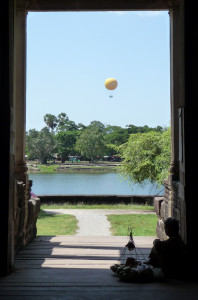I’m writing this post on the terrace of La Maison d’Angkor, our tiny boutique hotel in Siem Reap, Cambodia. I’ve dreamed to visit the site of Angkor Wat for more than 20 years when I first saw a photograph of it in a book of sacred sites.
In the past two days, I’ve seen some of the most extraordinary sights of my life in temple after sprawling temple built in the 12th century by King Suryavarman II. Unimaginable splendor on a massive scale, the “City of Temples” is surrounded by smaller temples, including Ta Prohm, hidden for centuries in the forest. Almost all of them are undergoing painstaking restoration, as broken stones are found and reassembled one by one.
Rebuilding a Life After Loss
Like its ancient temples, Cambodia is rebuilding itself after one of the worst tragedies in recent history. According to the Yale University Cambodian Genocide Program, 21 percent of the Cambodian population (approximately 1.7 million people) lost their lives to the Khmer Rouge regime of Pol Pot.
Our guide Phalin was 13 when she lost her home, as well as with her brother, sister and father, in what she calls “the time of the Khmer Rouge.” She speaks of her life “before the Khmer Rouge” and “after the Khmer Rouge,” and she often refers to 1986 as a kind of rebirth for the country, the year when Cambodia reopened to tourism.
It’s hard to imagine that the smooth, flat stretches of highway now bustling with tuk tuks, scooters and tour buses were razed during my lifetime, or that the forests surrounding Angkor Wat were once covered with landmines, or that families met “bad people” on the roads they had to walk. But, according to Phalin, that is how it was. I cannot imagine what she and millions of others here have had to find within themselves to carry on.
The young people I have met here are optimistic. They do not carry the scars of war that their parents carry. The lovely hotel bar staff have dreams and beautiful smiles to match them. Just out of high school, SaVinh is saving money to study engineering. At 26, Heak is recently married and has a seven-month old baby boy.
Greater and Lesser Losses
Although most of us are fortunate enough to never know this kind of loss, we all suffer losses. Life is full of times when the rug is pulled out from beneath you: you lose your job, you discover you have cancer, someone close to you dies. These are the times when you must use your personal resources to create what’s next. At these times you discover the quality of the investment you’ve made in yourself.
Most of us think about the creative process as a luxurious or even frivolous activity to bring pleasure to our lives. But I am convinced it is much more fundamental than that. When I look around me here at the new buildings, new roads, the number of tour buses, the laughing children, I see that creativity is the core energy of life. It is the fuel of the human spirit. And when I see how so much can come from so little, I feel as much awe for its power in the present as its glory in the past.
Up From the Ashes
And so I ask you, as I asked SaVinh last night, what do you dream to do? What drives you? What must you overcome to achieve it? And what are the ashes of loss that nourish your dream and enable you to grow?
No loss need be wasted, no matter how deep.
Do you agree? Or not?

